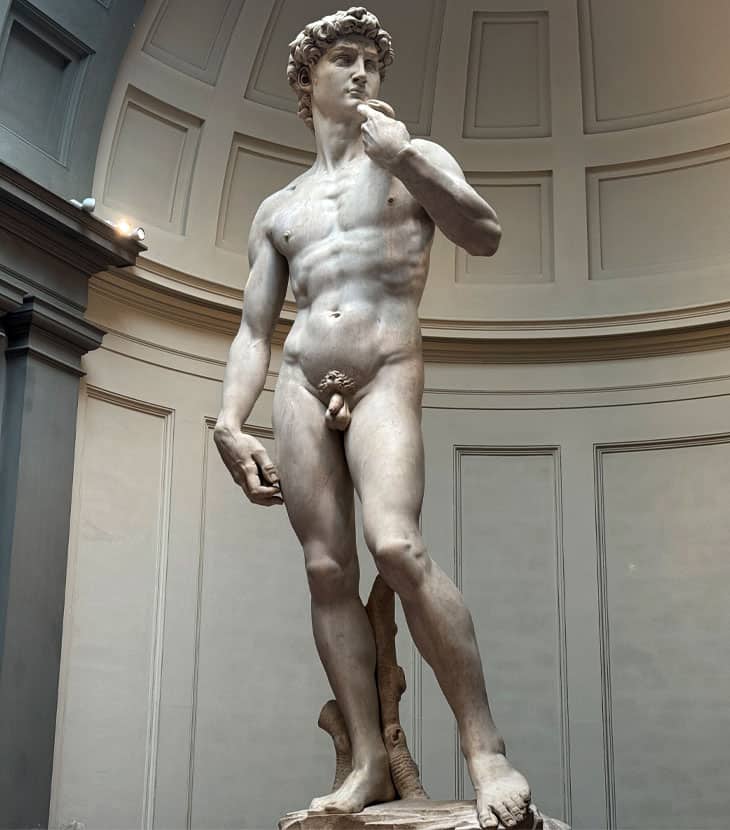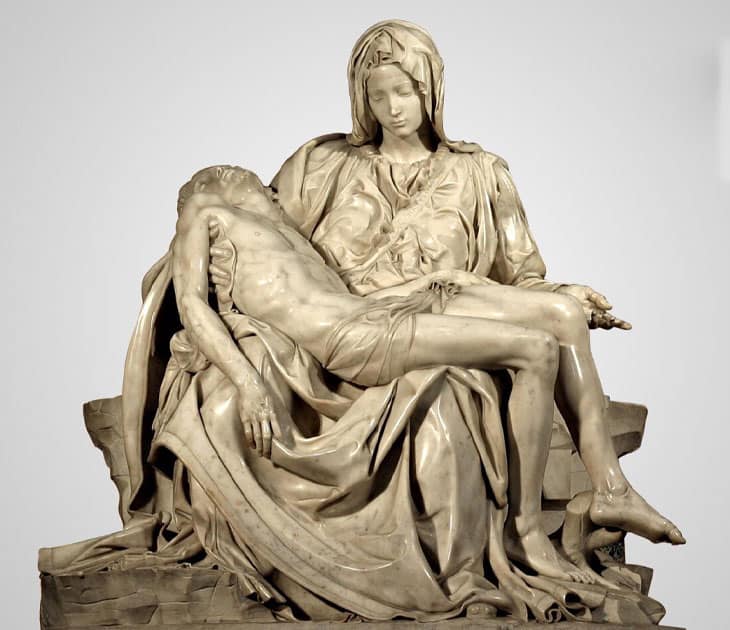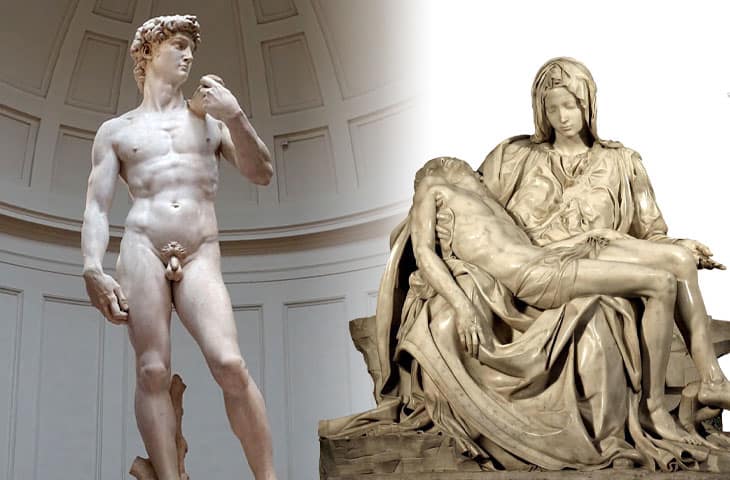Famous Michelangelo Sculptures
When we think of Renaissance art, one name stands out among the rest: Michelangelo. He’s the mind behind Pietà’s gentle curves and the grand David.
Art lovers or non-art lovers, there’s something for everyone in Michelangelo’s sculptures. Join us on this journey through time and stone. See why these masterpieces still inspires admiration today.
Michelangelo’s Most Famous Sculptures

David is perhaps the most famous of Michelangelo’s sculptures. Carved from a single block of marble between 1501 and 1504.
What makes David one of the most famous Michelangelo sculptures? It’s not just the impressive size or the anatomical accuracy. Michelangelo captured a moment of intense concentration, portraying the biblical hero just before his battle with Goliath. The result? A sculpture that seems to breathe with tension and determination.
Fun fact: The marble block Michelangelo used for this famous sculpture had been rejected by other sculptors due to its imperfections.

Pietà: A Marble Marvel of Emotion If David represents strength and courage, tenderness and grief. This heart-wrenching depiction of Mary cradling the body of Jesus is one of the most famous Michelangelo sculptures, created when the artist was just 24 years old.
The Pietà’s smooth, polished surface and the intricate folds of Mary’s robes showcase Michelangelo’s mastery of marble. But it’s the emotional impact that truly sets this famous sculpture apart. The serenity on Mary’s face contrasted with the lifeless body of Christ creates a powerful, moving scene.

Moses: Biblical Inspiration in Stone Last, but certainly not least, among famous Michelangelo sculptures, let’s talk about Moses.
This intense, bearded figure, part of the tomb of Pope Julius II, is a prime example of Michelangelo’s ability to infuse stone with life and energy. What is the most striking feature of this famous Michelangelo sculpture? Those renowned “horns” on Moses’ head. Don’t worry; Michelangelo wasn’t trying to turn Moses into a demon. This unique detail comes from a mistranslation of the Bible, where “rays of light” were interpreted as “horns.” It’s a quirky reminder that even the greatest artists can be influenced by the misconceptions of their time.
Where to See Famous Michelangelo Sculptures in Italy
If you’re an art lover planning a trip to see famous Michelangelo sculptures, Florence should be at the top of your list. This charming Tuscan city is home to some of Michelangelo’s most impressive works, including the star of the show – David.
Your first stop? The Accademia Gallery. Here, you’ll come face-to-face (well, face-to-knee, given David’s height!) with one of the most famous Michelangelo sculptures. Pro tip: book your tickets in advance to avoid the long queues.
But don’t stop there! Florence has more famous Michelangelo sculptures to offer. Head to the Medici Chapels to see his stunning sculptures of Dawn, Dusk, Day, and Night adorning the tombs of Lorenzo and Giuliano de’ Medici.
Rome: Eternal City of Michelangelo’s Art Next, on our tour of famous Michelangelo sculptures in Rome. Start your Roman adventure at St. Peter’s Basilica, where you’ll find the heart-wrenching Pietà. It’s protected by bulletproof glass these days, but don’t worry – you can still get a great view of this masterpiece.
While in Rome, don’t miss the chance to see Moses at the Church of San Pietro in Vincoli. The intense gaze of this biblical figure is sure to leave you spellbound.
Other Italian Cities with Famous Michelangelo Sculptures, feeling adventurous? Consider a trip to Bologna to see the small but exquisite Angel for the Ark of St. Dominic. Or venture to Siena to admire the statue of St. Peter in the Piccolomini Altar.
Remember, each of these locations offers a unique glimpse into Michelangelo’s genius. So pack your bags and get ready for an unforgettable Italian art adventure showcasing famous Michelangelo sculptures!
Michelangelo’s Revolutionary Sculpture Techniques
Ever wondered how Michelangelo turned chunks of marble into famous sculptures that have stood the test of time?
Let’s uncover some of his revolutionary techniques.
First off, Michelangelo was incredibly picky about his marble. He often travelled to the quarries of Carrara himself to select the perfect blocks for his famous sculptures. Talk about attention to detail!
But here’s where it gets fascinating. Unlike many sculptors who used preliminary models, Michelangelo often dove right in, carving directly into the marble. He called this technique “direct carving” and believed that the figure was already trapped inside the stone – his job was simply to free it. This approach contributed significantly to the unique character of his famous sculptures.
Michelangelo’s approach to carving was unique, too. He started from the front and worked his way back, almost as if he was peeling away layers to reveal the sculpture within. This method allowed him to constantly refine the most important parts of the figure, resulting in the lifelike quality that makes his sculptures so famous.
Finally, let’s talk about his finishing touches. Michelangelo was a master of surface texture. He could make marble look as soft as skin or as rough as tree bark, using different tools and techniques to achieve various effects. This skill is particularly evident in his famous sculptures like the Pietà and David.
These innovative methods set Michelangelo apart and contributed to the lifelike quality of his famous sculptures that we still admire today.
Michelangelo impact on art
He didn’t just create beautiful works; he revolutionised the entire field, influencing both his Renaissance contemporaries and artists for centuries to come.
During the Renaissance, other sculptors were in awe of Michelangelo’s ability to breathe life into stone. His dynamic poses, anatomical accuracy, and emotional depth set a new standard for sculptural art. Artists like Bernini and Giambologna drew inspiration from famous Michelangelo sculptures, pushing their own boundaries to capture that same sense of vitality and movement.
However, the influence of famous Michelangelo sculptures didn’t stop during the Renaissance. Fast-forward to the 19th and 20th centuries, and you’ll find his fingerprints all over modern sculpture. Rodin, often called the father of modern sculpture, was deeply inspired by Michelangelo’s unfinished works. The rough, expressive surfaces of Rodin’s sculptures owe a debt to Michelangelo’s non-finito technique.
Even today, contemporary artists continue to draw inspiration from famous Michelangelo sculptures. His ability to convey complex emotions through stone, his mastery of the human form, and his revolutionary techniques continue to challenge and inspire sculptors around the world.
FAQ – Famous Michelangelo Sculptures
How many famous sculptures did Michelangelo create?
Michelangelo was prolific throughout his long career, but pinpointing the exact number of his famous sculptures is tricky. About 20 finished sculptures survive today, but we know he created many more. Some were lost to time, while others remain unfinished – these incomplete works, known as “non-finito,” are fascinating in their own right, offering insight into Michelangelo’s creative process.
Where can I see famous Michelangelo sculptures?
Italy is the place to be for fans of famous Michelangelo sculptures! In Florence, visit the Accademia Gallery to see David and the Medici Chapels for his tomb sculptures. Rome houses the Pietà in St. Peter’s Basilica and Moses in the Church of San Pietro in Vincoli. For the adventurous, there are lesser-known works in cities like Bologna and Siena. Remember, it’s always a good idea to book tickets in advance, especially for popular venues like the Accademia.
What techniques did Michelangelo use in his famous sculptures?
Michelangelo was known for his innovative “direct carving” technique. Unlike many sculptors who used models, he often worked directly on the marble, believing the figure was already inside, waiting to be freed. He was also meticulous about choosing his marble, often visiting quarries personally. His ability to create various textures and his mastery of anatomy set his famous sculptures apart from his contemporaries.
How did famous Michelangelo sculptures influence Renaissance art?
Famous Michelangelo sculptures revolutionized Renaissance art through their unparalleled depiction of the human form, their ability to infuse stone with emotion and energy, and innovative techniques. These works raised the bar for anatomical accuracy and dynamic posing in sculpture. His famous sculptures inspired his contemporaries and continue to influence artists today, cementing Michelangelo’s status as one of the greatest sculptors in history.
Links you might find useful
Tickets & Tours
Accademia Gallery
Visitor Information
Opening Hours
Tickets and Tours
Accademia Online
Radio Accademia
Florence Attractions
Uffizi Gallery
Duomo Florence
Palazzo Pitti
More Florence Attractions





